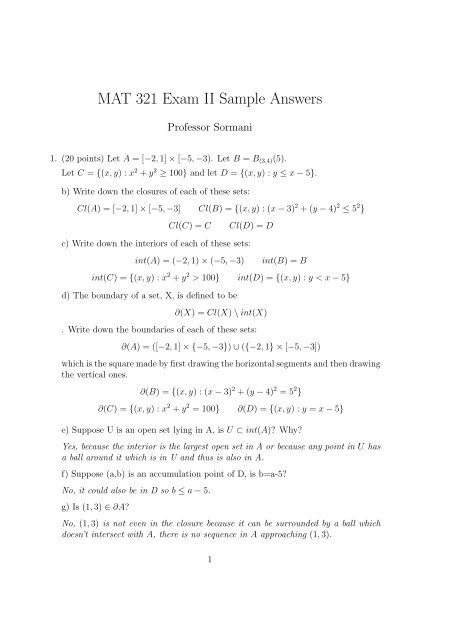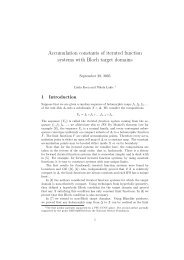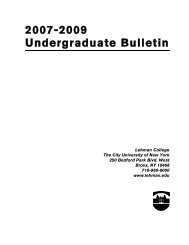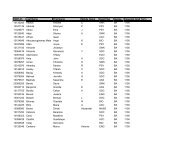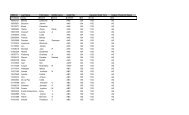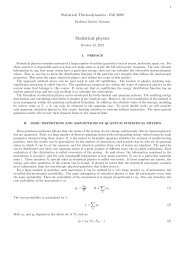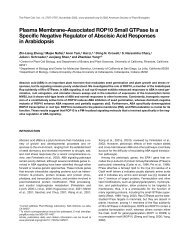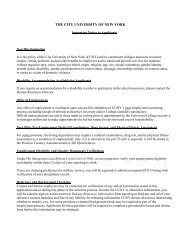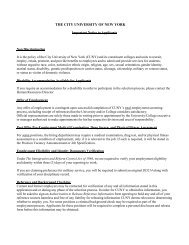Sample Exam Solutions
Sample Exam Solutions
Sample Exam Solutions
Create successful ePaper yourself
Turn your PDF publications into a flip-book with our unique Google optimized e-Paper software.
MAT 321 <strong>Exam</strong> II <strong>Sample</strong> Answers<br />
Professor Sormani<br />
1. (20 points) Let A = [−2, 1] × [−5, −3). Let B = B (3,4) (5).<br />
Let C = {(x, y) : x 2 + y 2 ≥ 100} and let D = {(x, y) : y ≤ x − 5}.<br />
b) Write down the closures of each of these sets:<br />
Cl(A) = [−2, 1] × [−5, −3] Cl(B) = {(x, y) : (x − 3) 2 + (y − 4) 2 ≤ 5 2 }<br />
Cl(C) = C<br />
Cl(D) = D<br />
c) Write down the interiors of each of these sets:<br />
int(A) = (−2, 1) × (−5, −3)<br />
int(B) = B<br />
int(C) = {(x, y) : x 2 + y 2 > 100} int(D) = {(x, y) : y < x − 5}<br />
d) The boundary of a set, X, is defined to be<br />
∂(X) = Cl(X) \ int(X)<br />
. Write down the boundaries of each of these sets:<br />
∂(A) = ([−2, 1] × {−5, −3}) ∪ ({−2, 1} × [−5, −3])<br />
which is the square made by first drawing the horizontal segments and then drawing<br />
the vertical ones.<br />
∂(B) = {(x, y) : (x − 3) 2 + (y − 4) 2 = 5 2 }<br />
∂(C) = {(x, y) : x 2 + y 2 = 100} ∂(D) = {(x, y) : y = x − 5}<br />
e) Suppose U is an open set lying in A, is U ⊂ int(A)? Why?<br />
Yes, because the interior is the largest open set in A or because any point in U has<br />
a ball around it which is in U and thus is also in A.<br />
f) Suppose (a,b) is an accumulation point of D, is b=a-5?<br />
No, it could also be in D so b ≤ a − 5.<br />
g) Is (1, 3) ∈ ∂A?<br />
No, (1, 3) is not even in the closure because it can be surrounded by a ball which<br />
doesn’t intersect with A, there is no sequence in A approaching (1, 3).<br />
1
2. (20 pts) TRUE OR FALSE WITHOUT JUSTIFICATION<br />
a) If x ∈ int(A) then there is a radius r x > 0 such that B x (r x ) ⊂ A. TRUE<br />
b) If K is a compact set in C([0, 1]) then K is closed and bounded. TRUE<br />
c) If K ⊂ C([0, 1]) is closed and bounded then K is compact. FALSE<br />
d) If x ∈ Cl(A) then there is a sequence of points x k ∈ A such that lim k→∞ x k = x.<br />
TRUE<br />
e) If f : K → (−∞, ∞) and K is a compact set and f is continuous, then there<br />
exists a point x 0 ∈ K such that f(x 0 ) ≥ f(x) for all x ∈ K. TRUE<br />
f) If f : A → B is a continuous function between metric spaces and U is open in<br />
B then f −1 (U) is open in A. TRUE<br />
2
g) If x k is a sequence of points in an interval [0, 1], then at least one of the following<br />
is true:<br />
Case I: there exists a subsequence which lies in [0, 1/2]<br />
Case II: there is a subsequence which lies in [1/2, 1]<br />
TRUE (HEINE BOREL PROOF)<br />
h) f is a contraction mapping iff f is Lipschitz with Lipschitz constant < 1. FALSE<br />
(MUST ALSO CHECK DOMAIN=RANGE BUT DO NOT NEED TO CHECK<br />
ONTO)<br />
i) The functions f(x) = |x|, g(x) = x 3 and h(x) = √ x − 1 are all in C([0, 1]).<br />
FALSE, (CHECK DOMAINS)<br />
j) The tangent function whose domain is (−π/2, π/2) has a bounded range. FALSE<br />
(THE RANGE IS (−∞, ∞) which is not bounded)<br />
Other true false problems could concern the Contraction Mapping Principle, open<br />
covers and finite subcovers, converging subsequences, completeness and Cauchy<br />
sequences.<br />
3
3. (20 pts) Proof Formating<br />
Write the definition of the following statements using for all and there exists notation<br />
and then write the first few lines of proofs of the following statements which<br />
use those definitions. You do not have to fill in formulas for the values you are<br />
“choosing”.<br />
a) The set A = {(x, y) : y > x} is an open set.<br />
DEFN: ∀p ∈ A ∃r p > 0 such that B p (r p ) ⊂ A.<br />
1) Let p ∈ A<br />
2) Choose r p = − − − − − − − − −−.<br />
3) We claim: B p (r p ) ⊂ A.<br />
b) The function sin : [0, π] → [−1, 1] is continuous at π/2.<br />
DEFN: ∀ɛ > 0, ∃δ > 0 such that | sin(x) − 1| < ɛ whenever |x − π/2| < δ. (Note<br />
sin(π/2) = 1).<br />
1) Let ɛ > 0.<br />
2) Choose δ = − − − − − − − (actually δ = ɛ see below).<br />
3) We claim: |sin(x) − 1| < ɛ whenever |x − π/2| < δ.<br />
or equivalently, sin( (π/2 − δ, π/2 + δ) ) ⊂ (1 − ɛ, 1 + ɛ).<br />
If one were to continue with this proof, one can just do the following:<br />
∫ π/2<br />
∫ π/2<br />
|sin(x) − 1| = |sin(x) − sin(π/2)| ≤ | cos(x)dx| ≤ | 1dx| ≤ |π/2 − x|<br />
x<br />
x<br />
or use unit circle trigonometry relating arclength, x, to heights and so on.<br />
c) The set K ⊂ C([0, 1]) is compact.<br />
DEFN: Given any open cover, there is a finite subcover.<br />
1) Let ⋃ α U α ⊃ K.<br />
d) The set A = int(B).<br />
DEFN: A is the largest open set in B.<br />
REWRITE DEFN: All open sets in B, are contained in A and A is open.<br />
1) Let U be an open set in B<br />
2) We claim U is in A.<br />
Later one will also have to show A is open.<br />
4
e) Returning to (a), try an alternate proof beginning using a theorem about preimages<br />
of continuous functions as follows.<br />
State the theorem: the preimage of an open set is open.<br />
1) Let f : A = {(x, y) : y − x > 0} → (−∞, ∞) be the function f(x, y) = y − x<br />
2) The set f −1 ((0, ∞)) is an open set because it is the preimage of an open set<br />
and f is continuous.<br />
3) So A is open because: A = f −1 ((0, ∞)).<br />
5
4. (20 pts) Lipschitz Functions<br />
a) Prove the function f(x) = x 2 /10 where f : [−2, 3] → [0, 9/10] ⊂ [2, 3] is<br />
Lipschitz. Well,<br />
where<br />
∫ y<br />
|f(x) − f(y)| ≤ | f ′ (x)dx| ≤ |x − y|M<br />
x<br />
M = sup x∈[−2,3] |f ′ (x)| = sup x∈[−2,3] |x/5| = 3/5<br />
so f is Lipschitz with Lipschitz constant 3/5.<br />
b) Prove it is a contraction map.<br />
Since the domain is the range is [2,3], and the Lipschitz constant is 3/5 < 1 it is<br />
a contraction map.<br />
c) What does the Contraction Mapping Principle tell us? Starting at x 0 = 1 what<br />
is x 1 = f(x 0 ), x 2 = f(x 1 ) etc and where does it converge?<br />
It tells us that there is a unique fixed point x 0 ∈ [−2, 3] where f(x 0 ) = x 0 and that<br />
taking a sequence {x j } as defined here we will appraoch that fixed point. Starting at<br />
x 1 = 1, I get x 2 = x 2 1/10 = 1/10, x 3 = (1/10) 2 /10 = 1/1000 x 4 = (1/1000) 2 /10...<br />
which is converging to the fixed point x 0 = 0. This can be verified to be the fixed<br />
point since 0 = f(0).<br />
d) Is f Lipschitz as a function on the domain [0, ∞)?<br />
No, there is no single Lipschitz constant which works for all pairs of points x, y ∈<br />
[0, ∞). Taking x = 0 and y j = j we see that<br />
|f(x) − f(y j )| = |y 2 j /10| = j/10|y j | = j/10|y j − x|<br />
so there can be no Lipschitz constant that works for all j.<br />
e) Suppose x 0 = 100, what is x 1 = f(x 0 ) and the rest of this sequence? Does it<br />
converge?<br />
x 1 = (100) 2 /10 = 1000, x 2 = (1000) 2 /10 = 10000, x 3 = (100000) 2 /10... which we<br />
could prove to be a diverging sequence but won’t bother.<br />
f) Is f a contraction mapping from [0, 10] to [0, 10]?<br />
It does map [0, 10] to [0, 10] becauce f(0) = 0 and f(10) = 10 and it is increasing.<br />
But it has two fixed points, 0 and 10 so it cannot be a contraction mapping. Notice<br />
|f(0) − f(10)| = |0 − 10| so the Lipschitz constant is ≥ 1 not < 1.<br />
6
5. (20 pts) Proof<br />
Prove that if f : A → (−∞, ∞) is a continuous function and A is a compact set,<br />
then there exists a maximum point a 0 ∈ A such that f(a 0 ) ≥ f(a) for all a ∈ A.<br />
Fill in justifications:<br />
1) Let b 0 = sup(f(A)) which exists by continuoum property of the reals since<br />
f(A) ⊂ (−∞, ∞).<br />
2) There exists b i ∈ f(A) such that b i increase to b 0 by definition of sup of f(A).<br />
3) There exists a i ∈ A such that f(a i ) = b i by definition of image: b ∈ f(A) iff<br />
∃a ∈ A s.t. b = f(a).<br />
4) A subsequence of a i converge to some point in A by hypothesis that A is compact.<br />
5) Let a 0 be the limit of that subsequence.<br />
6) We claim a 0 is the maximum point:<br />
Complete the proof of the claim:<br />
6a) lim a i = a 0 ∈ A and f is continuous on A, so lim f(a i ) = f(a 0 ).<br />
6b) f(a i ) = b i by step 3, so lim b i = f(a 0 ).<br />
6c) By step 2 lim b i = sup(f(A)) so sup(f(A)) = f(a 0 ).<br />
6d) The sup is an upper bound for A by definition of sup. So<br />
f(a 0 ) ≥ f(a) ∀a ∈ A.<br />
Now prove there exists a minimum point:<br />
Imitate the above carefully upside down.<br />
7


